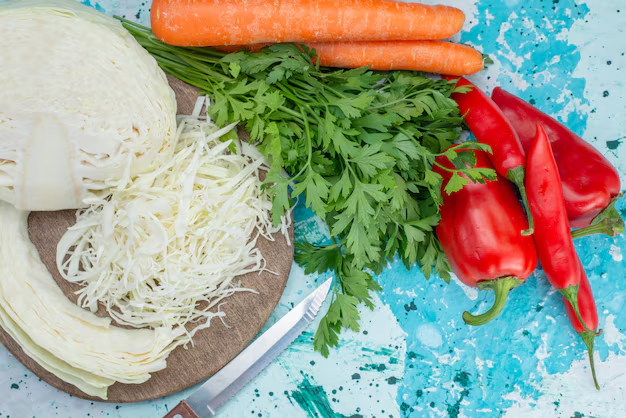Mastering the Art of Keeping Cabbage Fresh: Your Essential Guide
Cabbage is one of those versatile vegetables that can elevate your culinary game, from crunchy slaws to hearty soups. But how many times have you stocked up on this leafy delight, only to find it wilted and unappetizing when you finally get around to using it? Understanding how to properly store cabbage in your refrigerator can make the difference between a culinary masterpiece and food waste. In this guide, we’ll navigate different techniques and tips to ensure your cabbage stays fresh and vibrant.
🥬 Why Does Cabbage Need To Stay Fresh?
Before delving into storage techniques, let's understand why preserving the freshness of cabbage is vital. Not only does fresh cabbage offer superior taste and texture, but it also retains its nutrient profile better. Cabbage is rich in vitamins C, K, and various antioxidants, but these nutrients can degrade if the vegetable is not stored correctly. So, keeping cabbage fresh isn't just about taste—it's about maximizing its health benefits too.
The Science of Crisp Cabbage
To understand how to keep cabbage fresh, it's important to know what causes it to spoil. Cabbage, like other vegetables, loses moisture over time. When the outer leaves become soft or turn brown, it's a sign of dehydration or an unhealthy storage environment. Additionally, exposure to ethylene gas—produced by some fruits—can speed up the ripening and spoilage.
Key Factors Affecting Freshness
- Temperature: Ideal refrigeration temperature is around 32°F (0°C) to 40°F (4°C).
- Humidity: High humidity levels can help maintain hydration.
- Airflow: Proper ventilation inhibits mold and decay.
🥶 Proper Refrigeration Techniques
Preparation Before Refrigeration
- Do Not Wash Before Storage: Washing adds moisture that can promote mold. Store your cabbage unwashed.
- Trim Outer Leaves, If Needed: If the outer leaves appear damaged, trim them to prevent further spoilage.
Storage Options
- Whole Cabbage: Wrap it loosely in a plastic bag or similar wrap that locks in moisture but allows the vegetable to breathe. Ventilation holes can be handy.
- Cut Cabbage: If you've already halved or quartered the cabbage, wrap it tightly in plastic wrap to prevent it from drying out.
Position in the Refrigerator
Utilize the crisper drawer, which is designed for vegetables and helps maintain the appropriate humidity. Avoid placing cabbage near ethylene-producing fruits like apples and bananas.
Smart Tips for Extending Shelf Life
🛠️ How to Revive Limp Cabbage
If your cabbage starts drooping, all is not lost. Soak it in an ice-water bath for 20–30 minutes to refresh the leaves. This can revitalize the crunchy texture.
Use Double Protection
Consider placing your wrapped cabbage in an additional perforated plastic bag to manage optimal humidity and airflow.
Monitor Moisture
Check periodically to avoid condensation building up in the storage bag, as too much moisture can accelerate spoilage.
Alternatives to Refrigeration
While refrigeration is the go-to for long-term cabbage storage, there are alternative methods that might suit different needs:
Fermentation: A Flavorful Preservation
Transform your cabbage into sauerkraut or kimchi through fermentation. This not only extends shelf life but also introduces probiotics beneficial for gut health.
Cold Storage Outside the Fridge
In cooler environments, such as a root cellar or cold basement, cabbage can also be stored effectively. Ensure minimal light and consistent temperatures akin to fridge settings.
Drying or Dehydrating
Though less common, drying cabbage is another preservation method. Dried cabbage can be rehydrated for use in soups and stews.
📝 Quick Summary: Keeping Cabbage Fresh
Here's a concise summary to keep handy for maintaining your cabbage's freshness:
- Avoid washing cabbage before storing.
- Store in the fridge’s crisper drawer for optimal temperature and humidity.
- If cut, wrap tightly; if whole, wrap loosely but securely.
- Keep away from ethylene-producing fruits.
- Revive wilted cabbage with an ice-water soak.
Creative Uses for Your Fresh Cabbage
Now that you're equipped to keep your cabbage fresh, let's explore some ways to use it, ensuring nothing goes to waste:
🥗 Salads and Slaws
Cabbage adds crunch and color to salads. Combine it with carrots, a tangy dressing, and seeds for a nutritious side.
🥣 Soups and Stews
Add chopped cabbage to your soups or stews for added texture and nutritional benefits.
🌯 Wraps and Rolls
Use large cabbage leaves as an alternative to tortillas for healthy wraps or stuffed rolls.
Understanding Cabbage Varieties
Different types of cabbage may require slightly adjusted storage approaches:
Green Cabbage
The most common variety, known for its smooth, tightly packed leaves. Store as described for general cabbage storage.
Red Cabbage
Similar to green but richer in anthocyanins, giving it a distinct color. Storage techniques remain the same.
Savoy Cabbage
With crinkled leaves, savoy cabbage is more delicate. Protect its texture with gentle handling and correct humidity levels.
Napa Cabbage
Also known as Chinese cabbage, Napa is ideal for kimchi. Its soft leaves call for swift use after cutting to maintain freshness.
🌟 A Final Insight
Preserving the life and vibrancy of cabbage is not just about avoiding waste, but about enhancing the quality and healthfulness of your meals. By taking seemingly small yet impactful steps in the way you store cabbage, you are maximizing its potential both nutritionally and gastronomically. Happy storing and delightful cooking!
